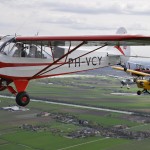The Vietnam War initiated the expansion and diversification of United States air power. After World War II and the Korean War, the U.S. military saw the need to create “heavy attack” bombers capable of being launched from aircraft carriers – which were becoming larger at the time.
A-3 Skywarrior: Units of the Vietnam War is author and pilot, Rick Morgan’s, story of the A-3 Skywarrior, its many diverse missions and the men who flew it. The A-3 is a unique aircraft. At the peak of its naval service, the A-3 was the largest and heaviest aircraft to be carrier-based. For this reason, the A-3 was called the “whale.”
The Douglas A-3 Skywarrior was designed by Ed Heinemann of the Douglas Aircraft Company. Heinemann also designed the A-4 Skyhawk and the Douglas A-1, among other airplanes. Heinemann designed the A-3, a nuclear attack bomber, to be capable of operating on the newer and bigger Forrestal class supercarriers. Heinemann, an accomplished airplane designer, was confident that the A-3 could operate on older Midway and Essex class carriers, with the aid of steam catapults and angled flight decks.
A-3 Skywarrior: Units of the Vietnam War is part of Osprey Publishing’s excellent Combat Aircraft series of military aircraft. This book is number 108 in the series. The quality of the series overall is commendable. The authors of these books are knowledgeable about their subject matter.
This series offers readers a fine balance between detailed text and fantastic photographs, most that are in color. Aircraft enthusiasts enjoy reading about the specs of an airplane, and hearing stories from the pilots who fly them. While explaining the merits and sour points of an aircraft, the Osprey Combat Aircraft books contain many quality photographs that capture the imagination of the reader. Several physical aspects of these books stand out. One of these is the hard paper in which the books are printed. It is a delight to turn the pages of these handsome books. Another is the beautiful color plates that highlight a given aircraft model painted in the respective livery of different military units.
The author of A-3 Skywarrior understands that he is writing for enthusiasts of U.S. naval aviation. Having piloted the A-3 himself, Mr. Morgan describes its specs and explains the capability of the A-3 like only those who have piloted the aircraft can.
The initial A-3 design called for an aircraft capable of flying over 2,000 miles while carrying up to 12,000 pounds of weaponry to its target. The A-3 had a three-man crew: Pilot, bombardier, navigator and crewman/navigator. Eventually, the A-3 saw many “versions,” including heavy attack bomber, reconnaissance and tanker. 282 A-3 Skywarriors were built.
A particularly interesting aspect of the book is the author’s description of the diverse ways that the A-3 was utilized by the U.S. Navy. This is a question of design integrity and anticipation of the changing demands that future military conflicts place on any aircraft.
Another important aspect of the book is the author’s explanation of how the A-3 was a beloved aircraft by those who flew it, even though some critics consider the A-3 a dangerous airplane. Part of the problem of the A-3, Morgan explains, is its large size especially in light of having to operate on aircraft carriers. Another problem is that the A-3 does not have ejection seats. Instead, the aircraft has an egress door on its belly. The A-3 was designed to fly high in the role of strategic bomber. The A-3 could reach 0.88 Mach at its 40,000 feet ceiling. The A-3 weighs 43,000lbs empty. This is a lot of weight for an airplane that is expected to launch from an aircraft carrier.
The main theater of operation of the A-3 was the Vietnam War. The aircraft was instrumental in operation Linebacker I and II, Rolling Thunder and Freedom Train. Its versatility allowed the A-3, in one configuration or another, to remain in operation from its introduction in 1956 to 1991, including two aircrafts that were called into service in the 1990 operation Desert Storm.
Eventually, the role and effectiveness of the A-3 was compromised by the demands of ever-changing technology and father time. The end of naval service for the A-3 came after concern that the aircraft was too large for carrier flying, even though it had served in that capacity since the 1950s. The A-3 Skywarrior was a workhorse for the U.S. Navy.












Geef een antwoord